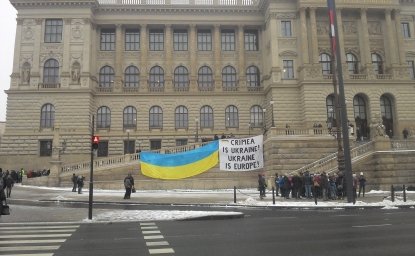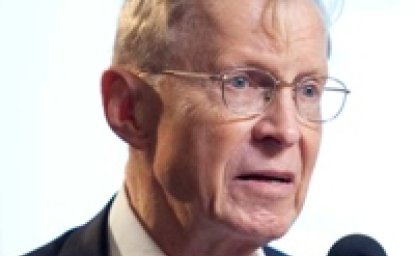The Evolution of Soviet Policies towards Dissidents

“Within the last few years, being a dissident in Russia today has increasingly started to look like the situation of dissidents in the Soviet period,” observed Peter Reddaway, Professor Emeritus of Political Science and International Affairs, George Washington University, and former Director, Kennan Institute. At a 26 September 2011 Kennan Institute event, Reddaway discussed the various types of dissidents during the Soviet era, and how the regime responded to their calls for a range of human rights throughout the Soviet Union from 1953 to 1986.
Reddaway began his presentation by describing the broad goals of Soviet dissidents. Those involved in the groups and movements “embarked on their dissent in a spirit of moral obligation.” Reddaway added: “They couldn’t do otherwise; they just had to stand up for decency, for individualism, for human rights—and if the authorities were going to punish them for that, well, that was just unfortunate.” The human rights movement was the broadest based of the different movements, because one of its purposes was to gather and process information from the widest possible range of groups throughout the Soviet Union. Several groups focused primarily on nationalistic aims; while their goals usually included the promotion of democracy, they primarily focused on greater autonomy for their nation, if not complete independence from the Soviet Union. Notably, these nationalist dissident groups existed in the Baltic republics, Ukraine, and the South Caucasus region—in particular, in Georgia and Armenia. Religious groups also had dissident components, including the Baptists, Catholics, Russian Orthodox, and Pentecostals. In numerous cases, Reddaway explained, religious dissident groups were similar to political dissidents as they were generally concerned about democracy promotion; however, their main focus was on religious freedom, which was greatly restricted—if not in most cases prohibited—in the Soviet Union. Additional issues for which dissidents fought included the rights to emigrate and to form free labor unions, and freedom from censorship in literature and the creative arts.
Upon outlining the main issues and groups that comprised the dissident movements, Reddaway extrapolated on the complex relationship between Soviet policymakers and dissidents. He explained that over the last twenty years, numbers of government documents related to dissidents had been declassified, if in some cases only temporarily. In particular, Reddaway noted that these declassified materials demonstrated how often the Politburo dealt with dissident issues, in contrast with how rarely the regime discussed the issues in public. Furthermore, the formerly-secret documents confirmed that the Politburo worked “intimately” with both the Central Committee and the KGB on issues of dissent. Despite the agencies’ close cooperation, declassified transcripts of Politburo meetings revealed that Soviet leaders sometimes experienced significant difficulty in arriving at decisions on countering dissent, for example in the cases of the well known figures of Andrei Sakharov and Alexander Solzhenitsyn. In such cases “they floundered around and didn’t know what to do,” noted Reddaway, after quoting from one of the transcripts.
Reddaway argued that in order to appreciate how the policy on dissidents evolved, it was necessary to understand the complex dynamic that existed between the various policymaking agencies of the Soviet regime. After Stalin’s death in 1953, the first concern of the Soviet leaders was to bring the secret police back under Communist party control. Closely allied with that initiative, Reddaway explained, was the decision to end the use of mass terror against the population. This was implemented soon after Stalin died. In connection with this trend, Khrushchev liberalized the legal codes between 1958 and 1961; however, Khrushchev’s political views became less liberal toward the end of his time in office, which left the Central Committee under Brezhnev divided on what to do with dissident groups.
Consequently, according to Reddaway the new leadership decided at frist, briefly, that the safest choice was to be liberal on dissidents. This resulted, in 1964-65, in the release of many Baptists and other prisoners from labor camps. “What we see from that time on,” Reddaway added, “is the emergence of a pattern of policy towards dissidents groups and movements that remained more or less stable for the next twenty years or so.” Central to that policy was the goal of keeping arrests of dissidents to a minimum: the Soviet leadership realized that to arrest too many people would be counterproductive and provoke criticism abroad. As a result, the regime found other ways of dealing with dissent, including issuing citizens with personal summonses and threats, dismissing them from their jobs or professional associations, and so on.
The policy against dissidents did not go unnoticed by Western countries, whose reaction sometimes influenced the Soviet regime to toughen or liberalize the policy. Reddaway cited that the start of détente in the early 1970s caused the Soviet leadership at first, in 1971-73, to tighten restrictions on dissent. Between 1974 and 1979, however, détente caused the liberalization of the policy against dissidents, when “the West drove a hard bargain” with the Soviet Union by including respect for human rights in the “Final Act” of the 1975 Conference of Security and Cooperation in Europe. When détente eroded and then ended in 1979 with the Soviet invasion of Afghanistan, the Soviet regime once more toughened its policy on dissent, as the USSR was “already in the doghouse over the invasion.” Thus it paid less attention through 1985 to the West’s stance on human rights, according to Reddaway.
The ultimate easing of restrictions against dissidents began in 1986 with the Gorbachev administration; the implementation of a liberalization that adopted much of the dissidents’ program on human rights and was enshrined in appropriate legislation. In conclusion, Reddaway illustrated some increasing similarities between the policy against dissidents under the Soviet and Putin administrations—and asserted that although dissidents are being increasingly targeted in Russia today, he remained hopeful that in due course the legacy of the Soviet-era dissidents would help to bring about change in a more liberal direction.
By Amy Shannon Liedy
Blair Ruble, Director, Kennan Institute
Author

Kennan Institute
The Kennan Institute is the premier US center for advanced research on Eurasia and the oldest and largest regional program at the Woodrow Wilson International Center for Scholars. The Kennan Institute is committed to improving American understanding of Russia, Ukraine, Central Asia, the South Caucasus, and the surrounding region through research and exchange. Read more

Explore More
Browse Insights & Analysis
Infographic | Russia's Illegal Annexation of Crimea

Chechnya as a Model of Modern Russia

